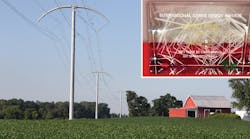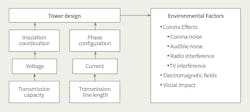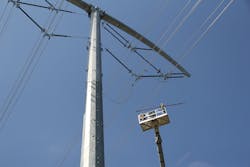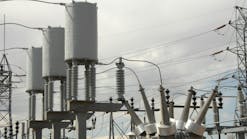The International Council on Large Electric Systems (CIGRE) and Korea Electric Power Corp. (KEPCO) jointly hosted the 2017 International Tower Design Award ceremony in Seoul, South Korea. Held during the CIGRE semiannual meeting, the competition received 26 tower designs from around the world. The designs featured various improvements from the appearance of the structure to a reduction in the environmental impact from the electrical facilities.
Among the designs, American Electric Power’s Breakthrough Overhead Line Design (BOLD) was awarded the grand prize. The judges recognized BOLD for its practical and environmentally friendly design, blending both performance and aesthetics. Additionally, in 2017, BOLD won Edison Electric Institute’s Edison Award and the National Association of Regulatory Utility Commissioners (NARUC’s) Utility Industry Innovation in Electricity Award.
Transmission Line History
The first transmission line in the U.S. was built in 1890 near Portland, Oregon. It was a 14-mile (23-km) 4-kV line built on single wood poles with multiple crossarms to support small-phase conductors. Since then, more than 600,000 circuit miles (965,600 km) of lines have been built in the U.S. New technology ultimately enabled utilities to build extra-high-voltage lines on latticed-steel towers over long distances to bring energy from remote areas to load centers. The higher the voltage, the taller and bulkier the transmission towers became with wider footprints. The invention of a steel pole — in lieu of latticed steel — in the late 1970s enabled designers to use monopoles with a much smaller footprint.
Rapid urban expansion occurred with population growth as well as advances in modern industry and agricultural technology. Obtaining space for new transmission line construction became a big challenge. Public perception shifted from development to people and the environment. Interest in the environmental impact from transmission lines has heightened. In many areas, traditional transmission tower designs are perceived widely as invasive facilities that negatively impact the landscape and reduce property values.
Over the years, distances between communities have shortened because of innovation in transportation and communication. While it is impossible to predict what people will want in the future, thinking about long-term infrastructure development goals can foster wiser and more sustainable decisions. New power-delivery technologies are being developed to maximize right-of-way (ROW) use, minimize visual impacts, enhance aesthetic appearance and moderate environmental impacts from electromagnetic phenomena.
CIGRE Competition
The was promulgated to showcase international transmission tower designs that embody environmental harmonization on actual transmission lines being installed or planned for installation. Elements reviewed in each design included the tower’s history of development, development difficulties and how they were overcome, development and installation costs, and other technical data, including transmission voltage, conductor and insulation design, span, design wind speeds and so forth.
Appearance Observations
Transmission latticed tower structures use many steel angles and occupy large areas, both above and on the ground, to support phase conductors. Using steel poles can reduce the number of structural members in the air and reduce the structure footprint.
The invention of high-strength steel enables buildings to soar to new heights, providing more space for living. At the same time, the new technology enables modern transmission structures to be low profile and deliver less visual impact. Modern welding technology enables utilities to use more tubular-steel poles on transmission line projects and benefit from easier installation. The volume of the structure is reduced significantly from that of traditional latticed towers.
Among the 26 designs submitted, 12 were in the form of a single pole and four were examples of low-profile double-circuit designs, such as BOLD. Two of the designs used compact delta-phase spacing design with interphase insulators to minimize the structure height.
The curved shape of the crossarms on BOLD monopole structures further reduces the perceived volume of space and presents the overhead plane of the structure elegantly. Proportioning arrangement of the phase conductors within the reduced space of the structure brings the wires closer to the structure center and reduces the space occupied by the wires. In turn, these arrangements reduce the length and cross section of the crossarm to provide an aesthetic rationale between the height and width of the structure.
The curved shape of the crossarm also fits with elements of nature and is more pleasing to the eye. Nature rarely presents angular elements in design, except for the mineral world. Trees, grasses, mountains and plains have principally smooth rounded forms and appeal to natural senses. Removing the angular nature of traditional transmission tower design provides a more naturally soothing appearance and presence in line design.
Function and Fit
The trend in modern transmission structure design is to be environmentally friendly by using a lower profile, smaller footprint and simpler design that yields less taking of habitat and use of less raw materials. From the electrical performance point of view, other considerations for environmentally friendly designs are to reduce electromagnetic fields, increase power flow and reduce line losses.
Compact delta-phase configurations of BOLD not only reduce the visual impact of the structure and wires but also enhance the electrical benefit of the line. The 345-kV BOLD lines have reduced inductance and increased capacitance. This results in up to 60% increase in surge impedance loading — a measure of the relative loadability among line configurations — along with lower line losses and reduced ground-level magnetic field levels of up to 50% at the edge of the ROW.
Higher-capacity transmission lines can minimize the need for additional lines, thus reducing future land use and environmental impacts. The use of existing ROW provides extra environmental benefits, such as minimizing land clearing and the elimination of habitat associated with a new route.
A compact delta-phase design not only gives lines enhanced electrical performance but also enables the use of a simple, low-profile design that blends into tree lines instead of protruding above them. When the ground wires and bundled conductors are closer to each other, birds safely pass over the line without having to increase altitude as they would for a traditional design to avoid collision with conductors.
Modern transmission structure design leverages physics and available materials to achieve the optimum outcome. However, it may also expose the materials to unexpected electrical or mechanical stresses. The first BOLD line was not built until thorough lab testing proved its predicted electrical and mechanical performance. Long-term field monitoring also was deployed on the first BOLD line project to ensure its performance was as good or better in the field than in the lab.
Each structure is an individual icon, giving each line its own identity. An adapted design has symbolic importance for the public and the territory. A specific site needs a specific project. The project may be upgrading an existing line, rebuilding a line within an existing ROW or an entirely new construction. A standardized, modernized transmission structure design — which has improved electrical and mechanical performance with a simple, elegant, low-profile appearance — can be applied easily on any of these projects with the least public objection.
Practicality
Many architectural elements are sized by the processes through which they are manufactured. Mass-produced elements are standardized and more cost effective. Modern design and fabrication technologies enable engineers and designers to convert an innovative idea into a real product. Maximum usage of off-the-shelf components on an innovative
design can reduce product cost significantly.
All materials have inherent strengths and weaknesses. Nonceramic insulators, like cables, are strong in tension. Latticed-steel masts are light and strong in compression and tension. Tubular-steel poles are strong in compression, tension, bending and torsion. Guyed-steel mast structures use steel cables in tension and steel masts in compression to resist the forces from wires. BOLD uses tension-only V-string insulator assemblies to support the conductors and steel poles to resist bending and axial forces. Taking full advantage of the strength of materials is a structural art to minimize structure weight and cost.
Permanent attachment plates for climbing and working on a transmission structure are a beneficial design element for construction and maintenance. THey also can have a negative visual effect on the overall clean appearance of the structure from a close view. However, structures on miles-long transmission lines are usually at a distance, in either oblique or spatial view, and rarely in frontal view. The visual impacts from the attachment plates and structure connections can be imperceptible at long distances and viewing angles. Including construction and maintenance requirements into transmission structure designs should have limited impact on appearance but improve the design’s practicality from both construction and maintenance aspects.
Meeting Challenges
At a time when expectations of the industry and those of the public are changing, modernizing the electric grid is a significant challenge. Today, more than ever before, the grid needs to be dynamic and adaptable. A changing generation portfolio and increasingly engaged landowners and siting boards are challenging transmission developers and system operators as never before. Among the 26 designs from the 2017 CIGRE International Tower Design Award competition, BOLD reflects the state of the art for environmentally friendly transmission structure design considerations and public acceptance.
Acknowledgement
The authors wish to thank Won-Kyo Lee of KEPCO and Dongil Lee of the Korea National Committee of CIGRE for their review of this article. ♦
Meihuan Zhu Fulk joined American Electric Power in 2006 and is a principal/structure engineer in the transmission line standards group, where she is responsible for structure and foundation design and analysis, conductor motion control, and fatigue design. She received a bachelor’s degree in structural engineering from Tongji University and a Ph.D. in engineering from Louisiana Tech University. She is a licensed professional engineer in Ohio; a member of IEEE, CIGRE, the American Society of Civil Engineers and the American Institute of Steel Construction; and holds 11 patents.
David E. Rupert advocates for and promotes the Breakthrough Overhead Line Design (BOLD) advanced transmission technology to entities that desire a more efficient transmission line design. He earned a bachelor’s degree in business administration in production and operations management from Ohio State University, a juris doctor degree from Capital University Law School and a J.D./MBA from Capital University Law School. He also attended American Electric Power’s executive education program at Ohio State University and the transmission and wholesale markets school at the University of Wisconsin.
Editor’s note: Visit www.cigre-korea.org/2017/en for more details on the CIGRE-KEPCO 2017 International Tower Design Award competition.






